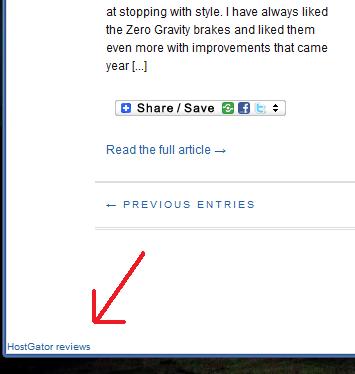So I’ve been slowly picking away at a spot on Google’s top ten searches for a few profitable keywords. This time last year I was between #9 and 11 – until recently I had gotten my site up to #5 for the target search phrase.
All of a sudden though, I’m down at number six and some site I’ve never seen or heard of before has jumped solidly in to the second spot for a whole bunch of related searches.
Checking out Yahoo’s Site Explorer, it looks like these newcomer has some 119,000 backlinks already from other domains, but how? What can we learn from this and can it safely be replicated?
Unfortunately, the first clue is a few dozen obviously sponsored links. This isn’t much of a surprise yet because I already noticed the exact same thing with the site that has been sitting at the #1 spot for the last while.
Yet even as the sponsored links were keyword specific and posted on high pagerank blogs, it didn’t seem like that alone would be enough to explain their suddenly incredible ranking and the 100,000+ backlinks they had amassed in total. I’d have to dig a little deeper…
After a few pages of the sponsored links, I started having a harder time spotting the competitors back links. Eventually, by looking in the source, I was able to find them in the very last line of code before the /body:
Now you might think that a sudden proliferation of site-wide footer links might trigger some kind of flags at Google, but since these are distributed across various IP addresses and geographical regions, it is being interpreted as completely legit.
On a lot of sites, this out of the way location is being covered up by social media footers like Facebook & Twitter toolbars. By every definition, they are “hidden links” that the website’s owners and visitors probably never noticed. Either it got snuck in to the thesis themes he’s distributing or it is being inserted by a plugin that seems to also point back to his domain with even more “user-invisible” links.
So what have I learned this week? 
 Build a website with five sales pages and nothing else. Buy links. Steal someone’s template and give yourself hidden footer links as credit. Unfortunately, I don’t think most of this advice is really solid for the long term success of a website, so I’ll be back to the research and the old grind of unique content again…
Build a website with five sales pages and nothing else. Buy links. Steal someone’s template and give yourself hidden footer links as credit. Unfortunately, I don’t think most of this advice is really solid for the long term success of a website, so I’ll be back to the research and the old grind of unique content again…


Perhaps the person owns a network sites and cross links between the sites.
It could possibly be a network, but from the regularity of posting and the number of sites it would definitely be one that required a whole lot of people participating. It does look like someone redistributing modified Thesis themes shortly after the big controversy between them & WordPress over the licensing options.
Since I wrote this post they’ve headed down from two to three and I got my spot at five so at least I’m back to where I was. It will be interesting to watch if they go back up to second or first because they don’t seem to be gaining new domains any more but they already have way more than anyone else targeting those keywords..
This is definitely not a good strategy for the long term. These types of links will most certainly raise a red flag to Google and even other SEO companies. Sure, it might be an immediate impact for a site, but the repercussions are not worth the short term success. Google does not like backlinks like these and can really hurt a website in the rankings. Just look at what JCPenny went through some time back. They were reaping rewards over the holiday season, but eventually Google found out and JCPenny was no longer on top of the rankings. This literally happened over a course of a few hours once Google found out. In all, links of this caliber are not good for long term success.